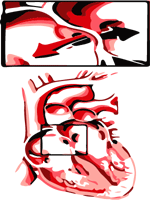Atrial septal Defect – ostium secundum, ostium primum
The most common form of an atrial septal defect is presence of ostium secundum type in the middle of the septal defect, while less common is ostium primum type, located lower in the septum and in these cases there are abnormalities in the mitral tricuspid valves. In both cases, normal oxygen saturated blood from the left atrium passes into the right atrium in thous way they increase cardiac output of right ventricle and pulmonary flow. In primum defect, mitral insufficiency causes stress of left ventricle.
The ostium secundum atrial septal defect is the most common atrial septal defect and occurs when the atrial septum is not completely closed during heart development. The ostium secundum creates a hole in the center of the wall that separates the two atria through which blood flows from the left to the right through the hole.
The ostium primum atrial septal defect is the most basic form of atrial canal or atrioventricular septal defect. The basic atrium is split aside by the septum primum from the front of a structure of the atrial septum in patients during fetal development. Ostium primum defect seem to be the most complicated defect to repair since he is associated with deviations of the two parallel heart valves. Ostium primum defect is less frequent but more dangerous than the ostium secundum defect. When it comes to merging of the superior endocardial cushions and inferior endocardial cushions then comes to closing of the the ostium primum. Patients with the ostium primum defect in childhood have problems with congestive heart failure because the heart does not pump blood as much as the body needs.
Ostium primum and ostium secundum atrial septal defect appear in a complex relationship of genetic factors and environmental factors. It actually is uncommon to discover the root cause of congenital cardiac malformations, for instance maternal rubella or perhaps chronically increased abuse of alcohol consumption from mother throughout embryo development.
A number of factors for example hypoxiation, ionizing radiation, particular medications have teratogenic effects. The risk of ostium primum and ostium secundum atrial septal defect in children of mother and father with congenital heart malformation is low about 3-4% and must not be an obstacle in the planning of the children.
The clinical picture of atrial septal defect – ostium secundum, ostium primum
Symptoms and signs of atrial septal defect – ostium secundum, ostium primum
The majority of patients with moderate atrial septum defect are asymptomatic. Children with ostium primum and ostium secundum usually have no signs and symptoms, however they may show minor physical underdevelopment and the tendency to respiratory infections. In the event that there is a shunt, that can lead to dyspnea, fatigue or cardiac decompensation.
There are visible palpable pulsations in the right ventricle. In a II and III intercostal space to the left of the sternum, a moderate systolic murmur can be heard as a result of increased flow through the pulmonary valve. On top of the heart a medium soft murmur can be heard, which is a result of the increased blood flow through the tricuspid valve, particularly in inspiration. Thrill is not common. The second tone is widely torn and does not change in relation to respiration. On fingers you can exhibit the deformation of terminal phalanges. With the increase of reduced hemoglobin in the arterial blood and decrease of degree of the oxygen saturation, comes to stimulation of erythropoiesis and the development of polycythemia.
Radiographic findings of atrial septal defect – ostium secundum, ostium primum
Large pulmonary arteries with strong pulsations, increased pulmonary vascular pattern and increased right atrial ventricle. The shadow on the heart is usually enlarged. Shadow on the aorta is reduced and poorly differentiated.
ECG of atrial septal defect – ostium secundum, ostium primum
The majority of patients have occurrence of electrical activity of the right ventricle, electrical axis deviation and hypertrophy of right ventricular in the case of the ostium secundum defect. Incomplete or complete right bundle branch block is encountered in most cases. In ostium primum defect there is a deviation of the electrical axis to the left with a rotation in the frontal plane in the opposite direction of the hands movement of the clock.
Special tests for atrial septal defect – ostium secundum, ostium primum
With cardiac catheterization it is possible to calculate the amount of blood that passes between the left and right atrium, then intracardiac and pulmonary pressures as well as pulmonary vascular resistance. The catheter can pass through the defect into the left atrium. Angiocardiography can detect ostium primum defect or a mitral regurgitation. The primary signals for the existence of ostium secundum and ostium primum are blood flow from the right atrium to the left and increase blood oxygen saturation in the cavity of the right atrium compared to blood samples taken from the mouth of hollow veins.
Treatment of atrial septal defect – ostium secundum, ostium primum
Small septum defects should not be treated surgically. Surgical treatment of atrial septum is requiring for those defects with a left right shunt and with two or three times higher systemic flow and with mild or no increased pulmonary resistance. Operational risk is small, so it is necessary operate on patients whose ratio between pulmonary and systemic flow is 3:2. Surgical intervention is not recommended in cases with pulmonary hypertension and reverse shunt, because of the risk of acute cardiac decompensation.
Prognosis of atrial septal defect – ostium secundum, ostium primum
Patients with small shunt can live a normal life, but with a big shunt they can survive to middle age or more, before it comes to the appearance of pulmonary hypertension or a cardiac decompensation. In early childhood ostium primum and ostium secundum atrial septal defect occurs rarely and can cause severe circulatory disorder, which can cause death in the first months of life. As time passes, there is a atrial fibrillation and pulmonary vascular resistance. A big shunt lead to physical disability in 40 years of age. Increased pulmonary vascular resistance caused by pulmonary hypertension rarely is encountered in childhood when it comes to ostium secundum, but it is common in the case of the septum primum defect after 40 years of life. In the presence of the ostium secundum a pulmonary hypertension can be developed.
The only successful treatment solutions is surgical treatment or artificial closure of the defect. Right time for surgical treatment can only be based on need for surgery and risks of surgery. Operative mortality with the use of the machine for extracorporeal circulation is low (< 1%) in patients under 45 years of age, who are not have decompensated pressure < 60 mm Hg.
Increases to 6-10% in patients over 40 years of age, they also have heart decompensation and increased pressure > 60 mm Hg. The largest number of survivors show marked improvement.
You may also like:
- The Blalock Taussig shunt
The Blalock Taussig shunt is a temporary surgical operation that is performed on newborn babies. The Blalock Taussig shunt is done when the heart is not delivering enough blood enriched with oxygen to the rest of the body.
- Glenn shunt procedure and bidirectional Glenn shunt surgery
Glenn shunt is a temporary treatment that is applied on children (preceding the Fontan procedure) to improve blood flow to the lungs.
- Fontan procedure
The Fontan procedure is an open heart surgical procedure used in children with a defect in the structure of the heart and great vessels which are present at birth.



